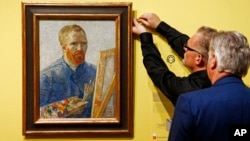It’s a question that philosophers have been grappling with for centuries: do you have to be a little crazy to be creative? Genetic researchers now think they have an answer: what makes people creative can also make them crazy.
Artist Vincent Van Gogh painted iconic images like Starry Night. Mathematician John Nash developed revolutionary ideas in economics. Considered geniuses in their art, both men also suffered from fits of hallucinations and bouts of deep emotional despair.
Geneticist Kári Stefánsson wondered about the differences between the brilliant brains that spawned jaw-dropping paintings and mathematical proofs and the average brains of the rest of us.
“To be creative, you have to be able to think differently, you have to be able to think outside the box. And When you leave the box in the morning, you may not be able to make it back to the box at night," said Stefánsson.
So he and colleagues from the deCODE Genetics group in Iceland gathered information on tens of thousands of actors, musicians, visual artists, and writers in the country and looked at their genes for clues.
The researchers found genetic variations that are also found in people who have schizophrenia, even if the artists did not have the disorder. Stefánsson compares it to a double-edged sword.
“Creativity, just like almost everything in our world, everything in our lives, comes with a price. This price is paid by this 1 percent who could develop schizophrenia. And this double nature of the qualities conferred on us by our brain, for some people this turns out to be good, for other people it turns out to be bad," said Stefánsson.
Stefansson says understanding the association between creativity and mental illness could help health professionals treating schizophrenia to contain the beast while keeping the beauty.
The study appeared in Nature Neuroscience.




